|
|
|
Sort Order |
|
|
|
Items / Page
|
|
|
|
|
|
|
| Srl | Item |
| 1 |
ID:
159612
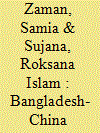

|
|
|
|
|
| Summary/Abstract |
The growing weight of China in terms of power and influence, defined either as a pole of attraction or as a pole of opposition, shapes the strategic environment of the Asia Pacific as well as the South Asian region. China has taken up its One Belt, One Road (OBOR) project, which is aimed at building trade and infrastructure network and ensuring access to trade and energy passage. It is both a development and diplomatic project for China focused on creating an economic and political sphere of influence not only in the region but also in the global context. Most countries in South Asia are engaged with this OBOR initiative. In this backdrop, Chinese President Xi Jinping visited Bangladesh in October 2016. During the visit, Bangladesh joined the OBOR initiative and both the countries pledged to upgrade their relations from the existing ‘closer comprehensive partnership’ to ‘strategic partnership’. In this respect, the main objectives of this paper are to understand the strategic partnership in the context of Bangladesh-China relations, to identify the factors shaping Bangladesh-China strategic partnership and to explore the implications of this partnership for both Bangladesh and China. The paper also elucidates its regional ramifications.
|
|
|
|
|
|
|
|
|
|
|
|
|
|
|
|
| 2 |
ID:
160466
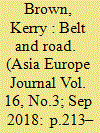

|
|
|
|
|
| Summary/Abstract |
We live in the era of storytelling and of leaders who are storytellers. That has always been the case. Max Weber argued that politicians are divided into sorcerers or warlords. With US President Trump, French President Macron, Russian President Putin, and above all with Chinese President Xi Jinping, we have people who might have access to plenty of assets of hard power, but who, aware of the cataclysmic risk of even appearing to deploy these, try to achieve their means by the magic power of stories.
|
|
|
|
|
|
|
|
|
|
|
|
|
|
|
|
| 3 |
ID:
155879
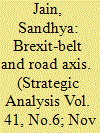

|
|
|
| 4 |
ID:
160005
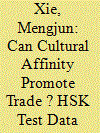

|
|
|
|
|
| Summary/Abstract |
As Chinese culture is “going out,” more and more non‐native Chinese speakers are beginning to study Mandarin and are taking the Hanyu Shuiping Kaoshi (HSK) test. Mandarin has become a very important trade language for the Belt and Road countries. This paper uses the difference‐in‐difference model and the Mahalanobis distance and the nearest neighbor distance matching methods to study the internal relationship between culture “going out” and foreign trade. We find that cultural affinity is an important factor in promoting trade, and that the HSK project has expanded China's exports to the Belt and Road countries. Culture's promotion effect in Asia is stronger than that in Europe. Culture's promotion effect shows the characteristics of regional differences, a time‐lag and a fluctuating upward trend. Therefore, further enhancing the international influence of its culture would help China to find a new source of export growth.
|
|
|
|
|
|
|
|
|
|
|
|
|
|
|
|
| 5 |
ID:
164418
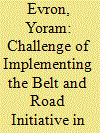

|
|
|
|
|
| Summary/Abstract |
Sceptics query China's economic and political ability to realize its Belt and Road Initiative (BRI). Less attention has been paid to BRI's implications for one of the defining features of China's foreign policy: low engagement in areas beyond its traditional sphere of influence. The Middle East is such a case. Addressing this issue, the article explores the mutual impact of China's low political involvement in the Middle East and BRI's realization. Distinguishing cross-border connectivity projects from other BRI-associated activities, the article examines the challenges to executing BRI-related projects in Israel. It finds that realizing connectivity projects – the essence of the BRI vision – will require China to increase its regional engagement, a shift that it has so far avoided.
|
|
|
|
|
|
|
|
|
|
|
|
|
|
|
|
| 6 |
ID:
173801
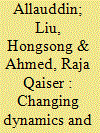

|
|
|
|
|
| Summary/Abstract |
The China–Pakistan relation has historical underpinning. By establishing diplomatic relations in 1951, each passing decade has witnessed that China–Pakistan relations coalesce into a dependable friendship. This relationship has gone beyond the usual diplomatic and political comfortability transcending to a broad-based framework incorporating economics, trade and defence dimensions. In the given context, this paper is an empirical study aiming to examine the historical process in the gradual culmination of China–Pakistan relations into a broad-based partnership. It further evaluates the present nature of relationship between the two countries and the prospects it holds in the wake of changing world scenario. By primarily focusing on the secondary sources of data and interviewing key people from the decision-making circles, this paper argues that the China–Pakistan relation is deep-rooted in the history and the on-going collaboration between China and Pakistan in defence and economy is the natural evolution of their mutual ties.
|
|
|
|
|
|
|
|
|
|
|
|
|
|
|
|
| 7 |
ID:
158089
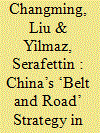

|
|
|
|
|
| Summary/Abstract |
The focus of this article is two-pronged. First, it highlights China’s ‘One Belt, One Road’ (OBOR) initiative as a Eurasia-centred project that, distinct from the twentieth-century Eurasianism, aims to introduce a new comprehensive integrationist agenda to the Eurasian strategic landscape. Second, it compares the US-led Euro-Atlanticism and the emerging Eurasianism, holding that while the former has historically stressed security over development (development is seen as contingent on the establishment of a hard security regime), the latter prioritises development over security (security is viewed as contingent on the establishment of an inclusive economic regime). Thus, this research argues that, if implemented successfully, OBOR could challenge Euro-Atlanticism as the long-held normative paradigm of interstate relations by offering a systemic alternative.
|
|
|
|
|
|
|
|
|
|
|
|
|
|
|
|
| 8 |
ID:
153114
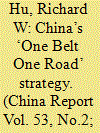

|
|
|
|
|
| Summary/Abstract |
This article examines One Belt One Road (OBOR) strategic implications for India. It is argued that the
implications need to be considered within the framework of the future development of the China–India
relationship. The relationship is largely constrained by and embedded in the security dilemma at the
present time. Taking the opportunity offered by the OBOR initiative, China and India should explore
building a ‘new model of major power relationship’ between the two countries. While the border issue
and regional security rivalry may not find an easy way out, it should not impede the leaders of the two
countries from expanding the areas of cooperation and building up strategic trust between the two peoples.
Beijing and New Delhi can and should find more areas of cooperation on non-traditional security issues,
such as food security, water, energy, strategic metals, common concern over environmental protection and
climate change and reforming the post-war international economic order.
|
|
|
|
|
|
|
|
|
|
|
|
|
|
|
|
| 9 |
ID:
149166
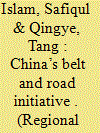

|
|
|
|
|
| Summary/Abstract |
The Belt and Road initiative, proposed by Chinese President Xi
Jinping in September 2013, consists of a land-based economic belt and a
maritime road. It aims at bolstering trade within Asia as well as with Africa
and Europe by building infrastructure for integrating Asia. Both the land-based
economic belt and the maritime road would connect Bangladesh with China,
Southeast Asia, and other South Asian countries, which will promote trade,
development of infrastructure and resources, industrial cooperation, and
financial integration. The initiative will provide a bridge between minds and
cultures of the people, and bring the two civilizations—Chinese and South
Asian—closer. The ancient Silk Road also passed through Bangladesh and
Myanmar from Yunnan province of China as well as other South and Southeast
Asian countries. The centre of the economic network of the countries located
along the Bay of Bengal was Bengal (Bangladesh). Although Yunnan was landlocked,
it had built a historical relationship with the peoples of the Bay of
Bengal through the land-based route. The geo-strategic location of Bangladesh
has thus made it important with regard to the present Belt and Road initiative.
|
|
|
|
|
|
|
|
|
|
|
|
|
|
|
|
| 10 |
ID:
147977
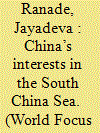

|
|
|
|
|
| Summary/Abstract |
Dominance of the South China Sea is not merely a territorial issue for China but, more importantly, one which it regards as a major step towards recognition as an unrivalled Asia-Pacific power that can arbitrate on global and regional issues along with the US. Since the 18th Congress of the Chinese Communist Party (CCP) and appointment of Xi Jinping simultaneously to China’s three top posts in November 2012, the world is witness to a new thrust to China’s already assertive foreign policy. Early in Xi Jinping’s term, China launched major, bold, geo-strategic initiatives aimed at expanding China’s diplomatic and economic influence and military power well beyond its frontiers.
|
|
|
|
|
|
|
|
|
|
|
|
|
|
|
|
| 11 |
ID:
145200
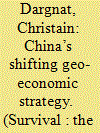

|
|
|
|
|
| Summary/Abstract |
Against an international backdrop of slowing global trade and the rise of the service industry over manufacturing, the Chinese economic model is approaching exhaustion. China is struggling to confront over-indebtedness, excess production capacity, declining competitiveness, unfavourable demographics and the flight of capital. In response, the Chinese government is adopting a change in geo-economic strategy, based on two major initiatives: a transformation of its domestic financial system, and the ‘One Belt, One Road’ (OBOR) project. The success of these initiatives will be vital to China’s economic development, political and social stability, and geopolitical emergence.
|
|
|
|
|
|
|
|
|
|
|
|
|
|
|
|
| 12 |
ID:
147975
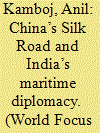

|
|
|
|
|
| Summary/Abstract |
The OBOR strategy has become China’s major foreign policy goal, Beijing will promote this initiative economically, politically, militarily and culturally over the next eight to ten years. For India, there are lessons from this. New Delhi also benefits from at least reasonable ties with most stakeholders in the New Silk Road, including Iran, where India has invested heavily in the Chabahar Port. But India must also make serious efforts to strengthen its links with Southeast Asia, and for this it must maintain stronger ties with Bangladesh. New Delhi will also need to work towards a manageable relationship with Pakistan, which would not only facilitate pipeline projects like TAPI, but also enable access to Afghanistan and Central Asia.
|
|
|
|
|
|
|
|
|
|
|
|
|
|
|
|
| 13 |
ID:
154727
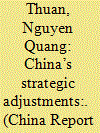

|
|
|
|
|
| Summary/Abstract |
After the eighteenth Congress of the Chinese Communist Party, China adjusted its diplomatic strategy and
transformed its pattern of economic development. This has had and will continue to have both a positive
and a negative impact on the international financial institutions and the regional and global economy.
The ‘One Belt, One Road’ (OBOR) strategy, combined with the Asian Infrastructure Investment Bank
(AIIB) and the internationalisation of the yuan, is the main focus, and exerts a strong impact on the
existing international financial institutions as well as the economic relations between China and many
other countries in the world. It has attracted many developed and developing countries to join the AIIB.
It also has made many emerging economies become closely linked to China. Moreover, it contributes to
the emergence of many ‘asymmetric’ pairs of economic relations between China and its neighbours. China
is now connected with Europe through an overland route as well as through the boosting of economic,
trade and investment ties between Asia and Europe. Furthermore, while Europe has been concerned
about China’s unfair competition and the dependence on Chinese investment, ASEAN has increasingly
deepened the mutual economic dependence between itself and Beijing. A negative outcome of this is the
rising economic dependence on China of quite a few ASEAN member states, including Vietnam.
|
|
|
|
|
|
|
|
|
|
|
|
|
|
|
|
| 14 |
ID:
159254
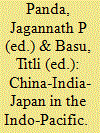

|
|
|
|
|
| Publication |
New Delhi, Pentagon, 2018.
|
| Description |
xviii, 398p.hbk
|
| Standard Number |
9789386618429
|
|
|
|
|
|
|
|
|
|
|
|
Copies: C:2/I:0,R:0,Q:0
Circulation
| Accession# | Call# | Current Location | Status | Policy | Location |
| 059404 | 320.12/PAN 059404 | Main | On Shelf | General | |
| 059405 | 320.12/PAN 059405 | Main | On Shelf | General | |
|
|
|
|
| 15 |
ID:
154095


|
|
|
|
|
| Summary/Abstract |
Since its unveiling at the end of 2013, China's “One Belt One Road” initiative, or BRI for Belt and Road Initiative, as it is now officially known11. The official standardized English translation of 一带一路 ‘yidai yilu’ became “Belt and Road Initiative” in 2015, after the publication of a joint statement by the National Development and Reform Commission, the Ministry of Foreign Affairs and the Ministry of Commerce, specifically demanding that “initiative” should be in the singular instead of the plural form, and that the words “strategy”, “project”, “program” or “agenda” should not be used. See Xie Tao, “Is China’s ‘Belt and Road’ a Strategy?” The Diplomat, December 16, 2015, http://thediplomat.com/2015/12/is-chinas-belt-and-road-a-strategy/.
View all notes
—an awkward label that does not do justice to the poetry of its Chinese name, yidai yilu—has clearly emerged as one of President Xi Jinping's top priorities. The sheer size and ambition of the project, to which the regime has already committed substantial financial, diplomatic, and intellectual resources, gives it the potential to become one of the defining economic and political constructs of the first half of the 21st century. Designed to stimulate economic development by dramatically enhancing regional interconnectivity, the BRI aims to integrate the world's largest landmass—from Vladivostok to Lisbon, from Moscow to Singapore—through a dense network of both “hard” and “soft” infrastructure all linked to China (from transportation, telecommunications, and energy infrastructure to financial integration and political coordination). If the project succeeds as Beijing hopes, it will transform Eurasia's geopolitical landscape and cement China's position as the preponderant regional power.
|
|
|
|
|
|
|
|
|
|
|
|
|
|
|
|
| 16 |
ID:
158243
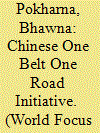

|
|
|
|
|
| Summary/Abstract |
The OBOR is a signature foreign policy initiative of Chinese leadership having a long term vision of establishing China as a world power. China is celebrating 100 th anniversary of Chinese Communist Party in 2021, 100th Anniversary of PLA in 2027, and 100th anniversary of communist rule in 2049, therefore the OBOR initiative is an attempt to revive the old glory of different Chinese Empires as well as to commemorate the epoch making events of the past century.
|
|
|
|
|
|
|
|
|
|
|
|
|
|
|
|
| 17 |
ID:
154438
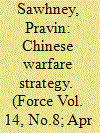

|
|
|
| 18 |
ID:
173954
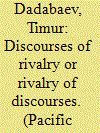

|
|
|
|
|
| Summary/Abstract |
This article analyzes discursive strategies of China and Japan to integrate newly emerging Central Asian (CA) states into their internal and external policies, norms and concepts, according to which they justify both their actions in CA and CA responses to these policies. This article elaborates the concept that to a certain extent, the interests of China and Japan in CA are similarly focused on mineral resources and political stability. However, these countries employ different discursive strategies to frame their approaches and goals. This article also emphasizes that the discourse of competition for regional domination prevalent in the English language, Russian and some CA media is largely an imposition of a zero-sum vision of international relations that is not proven by any empirical evidence. On the contrary, many of the projects conducted both by China and Japan are compatible – if not supplementary – and do not necessarily imply exclusivity of interest. At the same time, both China and Japan have different ways of reasoning their CA engagements, resulting in a rivalry of discourses for the ‘hearts and minds’ of the CA population.
|
|
|
|
|
|
|
|
|
|
|
|
|
|
|
|
| 19 |
ID:
182064
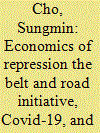

|
|
|
|
|
| Summary/Abstract |
Since President Xi Jinping started his second term in 2017, Chinese forces
have imprisoned up to two million Uyghurs in detention camps, which
Beijing claims are educational centers for vocational training.1 The international community has alleged human rights violations in Xinjiang, but Beijing
defends that China’s measures are necessary to eradicate the so-called “three evils
of terrorism, separatism, and extremism.”2 Regarding Beijing’s motivations behind the repressive measures in Xinjiang, much analysis has focused on the Chinese Communist Party’s (CCP) views of internal security, social control, and
Han-ethno nationalism
|
|
|
|
|
|
|
|
|
|
|
|
|
|
|
|
| 20 |
ID:
141576


|
|
|
|
|
| Summary/Abstract |
On 14 March 2013 President Xi Jinping took over as the president of People’s Republic of China, and also became a ‘paramount leader’, wearing all three hats simultaneously: the all-powerful general secretary of the Communist Party of China and Chairman, Central Military Commission, in addition to being the President.
|
|
|
|
|
|
|
|
|
|
|
|
|
|
|
|
|
|
|
|
|